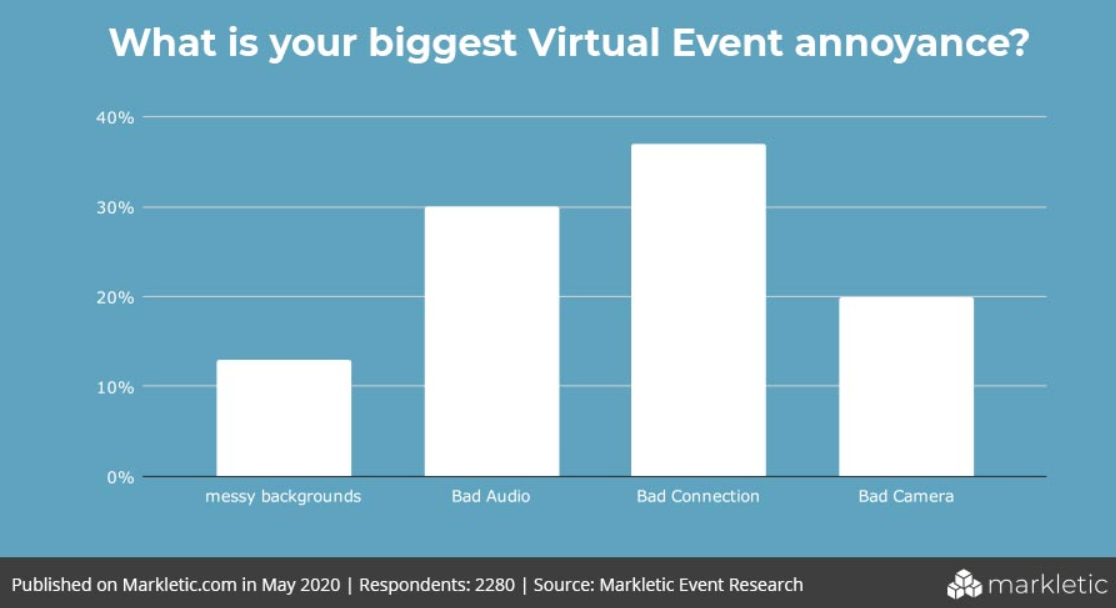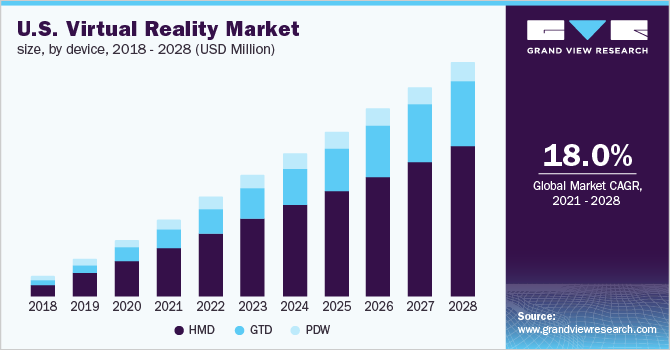Wait, you're saying I don't actually have to go to this five-day-long vacuum salesman conference filled with tweed-wearing middlemen, and can do it all online instead? Sign me up.

Virtual events were the big star of 2021, keeping us in contact with friends and family, and letting me still attend my mediaeval pottery class and watch livestreams of puppies.
The numbers speak for themselves. The virtual events industry is expected to grow ten-fold over the coming decade - from $78B to $774B. So, it shows no signs of slowing down.
In fact, 72% of respondents to a Vimeo survey stated that they are expecting to attend the same number, or even more, online events even when in-person events return.
This suggests that the convenience, alongside helpful digital advancements, allow for an experience that has its own benefits, comforts, and added value rather than just being a replacement for in-person.
Looking for the down low from a download? Well, check out our State of B2B Digital Event Experience 2023 eBook, here!

So, let's have a look at some upcoming trends in the industry, and how you can implement them in your next campaign.
Virtual events secure their place
Okay, okay. This one's obvious, from the fact we're talking about this topic at all. Thing is, virtual events have increased in popularity by 35% since 2020. So, that's more than when we were forced to do virtual events. People are coming back to the medium for other reasons besides necessity.
“Virtual is not going away,” says Scott Gould, author and engagement consultant. “We need to imagine a future where virtual is going to be the bulk of what we're doing. We need to plan with that in mind.”
Virtual events were embraced by tech companies, who provided innovative elements of interaction, added value, and genuine engagement, which forced other industries to follow suit.
Amelia Ibarra, Author for SaaStr noted that these forms of webinars tended to build a sense of community.
“We added a lot of roundtables,” she said.
“We added a lot of small group sessions because a lot of really great, like-minded people came through our digital events –– people in our community who should be raised up to a speaker level.”
These small sessions often allowed for increased personalisation in two ways. Number one: the virtual aspect allowed for a wealth of insightful data to be poured into the hands of marketers, allowing them to provide an intimate and in-depth experience for their clients. Number two: the small scale that most online events stick to creates a far more engaged audience, in terms of providing a specific experience to a niche group instead of having to appeal to a hall filled with thousands of people.
So, virtual events help build that all important community, and in return, these communities help build your events. and virtual provides marketers with an ability to provide consistency; instead of one event a year, they can invest in frequent, scalable content, and provide year-round touch points.
Ain't no river wide enough, ain't no valley low enough etc. etc.
Traditional limits put in place onto events have been almost eradicated thanks to virtual events.
This trend in particular offers marketers the ability to spread live events across different times and markets, providing them and their audiences with a flexible asynchronous content approach.
“We need to think about events less as ‘one and done’ and more as an evergreen and evolving mission,” said Song Novelli.
So, instead of throwing an event and being done with it, your team should think bigger. This could be offering dedicated live content to different regions in different time zones, providing quality on-demand content, producing specific content for sales kick offs, or even using content to introduce warm leads to more information about your product.
Each of these can be tailored and personalised to each prospect's needs and pain points.
Like we've mentioned above, virtual events provide a flexibility and accessibility that adds a real level of inclusivity to your event and brand.
Events tech really breaks down barriers by opening up these experiences to clients who may have previously been left out. This could be for logistical, geographical, financial, or even technological issues.
So, now your event is available to a wide range of people, you've got to keep a few things in mind.
- Language. You could use a live transcription AI for captioning, or provide a choice of hosts.
- Accessibility for Disabilities. This could be captioning, like above, or a sign language interpreter, or even screen reading technology
- Short, condensed content. One of the most appealing aspects of virtual events is the ability to attend, without having to sacrifice a huge amount of time. Having shorter content means attendees can take part in the webinars that appeal to them most, without the commitment of giving up 3 days to attend a conference.
- Reduced cost. This might look like offering your webinars for free, or a reduced price. Remember, your virtual event is likely to cost a hell of a lot less than an in-person event - use these savings to provide an affordable virtual experience with added benefits.
Letting the machines take over
The tech advancements that resulted, out of necessity, from Covid have accelerated digital transformations across a bunch of industries.
But specifically for marketing, it has allowed events technology to go beyond just using an algorithm. Instead, marketers can use machine learning and artificial intelligence that can adapt to any changes in your audience's wants and needs.
Events with more than 50 sessions or 5,000 participants benefit the most, and there is a positive return on investment.
Basically, it means you get a real-time update of your customers, and avoid being left behind.
“Machine learning creates personas that are never cemented in concrete,” said Joe Schwinger speaking at the EventMB 2022 Event Trends Summit.
Best in breed event tech stack
So, it might be easier to have an all-in-one approach. Events tech vendors might even highlight the benefits of it till the cows come home. A nice, pre-packaged solution. Lovely.
The thing is, trends are pointing in the opposite direction. The rise in best in breed event tech stacks is growing.
According to SpotMe CEO Pierre Metrailler, clients don't want these all-in-one systems, instead they want a stack crafted with the best tools for them, and the best tools available for the function. “To deliver great experiences, you’ve got to use the best tool for each element of an event,” he says.
The new, shiny, and improved events tech that has sprung up is perfectly suited to integrate with CRM and marketing automation tools.
Metrailler also recommends a mindset shift. Events organisers should move away from thinking about events as a standalone tactic, to one point in a larger marketing journey or campaign. So, each tool and point shouldn't work in silos. Like providing an asynchronous content campaign, your focus should be on providing something which is constantly accessible, well-oiled, and overarching.
Hey good lookin'
Now, this isn't about hiring A-listers to host your virtual events. I'm not saying hiring Brad Pitt wouldn't help, but that's not always in the budget.
Instead, marketers will need to take into account the rising expectations for experience. Audiences expect your event to be visually appealing, exciting, and engaging.
So, this means creating high-quality videos. This might be the on-demand content, promo videos, recaps, or trailers. People are more likely to give you their time if the content is eye-catching and appealing.
Also, make sure your speakers are adding value to the webinar. Attendees want to hear interesting subject matters from relevant experts.
Another thing to consider - production value. We've gone beyond the webcam. Think about investing in a good microphone and camera.

During Hopin's EventMinded digital event, the company presented it's audience with a high-production opening focusing on the struggles of the pandemic. The speakers were then handed iPads and viewers were able to watch their reactions as colleagues spoke on the impact of their leadership.
Barbara Palmer notes that this example made the event feel more like high-quality broadcast entertainment, than a webinar.
"I felt like I was witnessing something special," she said.
"And it introduced the topic of the emotional toll that the pandemic has taken on event professionals, and the support that can be found in community, in a way that invited, rather than demanded, engagement by participants. I hope it’s a sign that we’ll see more digital events use creative ways to tell stories — and break out of the webinar mould — in the future"
According to Joe Pulizzi, marketing and media are likely to combine forces. Tech companies will take their media in-house, to provide engaging content specifically for their audience.
Everyone’s a tech company now, or at least they think they are. At the same time, everyone's a media company. At least our process is.”
Basically, if you look at most marketing departments today, they should be looking awfully similar to media companies.
Hubspot has been doing this for a long time, especially when we saw their acquisition of The Hustle.
Joe thinks, because of the abundance of cash, and lack of patience, we’ll be seeing less audience building, more buying. And there are a lot of media platforms to buy.
“Whatever your industry is, there’s a blogger, a podcaster, a YouTuber, a Twitch streamer that is available for sale. Right now. At whatever price.”
The metaverse is also changing expectations for event experiences, especially among Millennials and Gen Z. So, to win the attention of the future decision-makers and buyers, it might be worth considering some out-there ways of interaction.
Once again, here comes asynchronicity. These generations will be looking for constantly-available content, with no set chronology, plus a sense of genuine interaction and exploration.

Looking for the down low from a download? Well, check out our State of B2B Digital Event Experience 2023 eBook, here!
